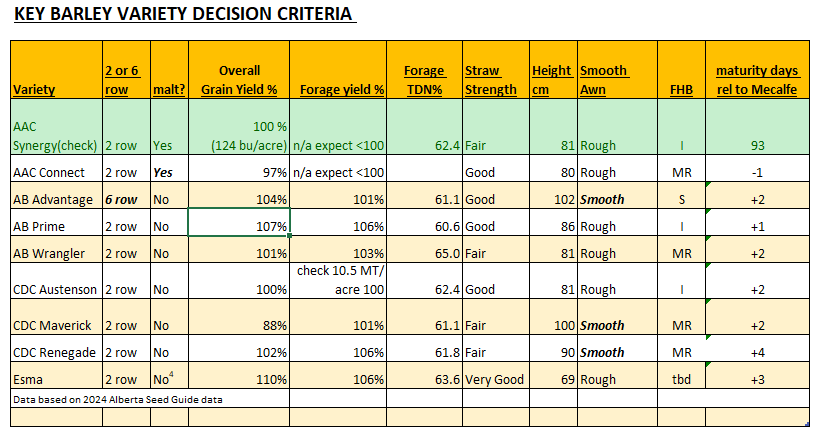(800) 563-7333
This handy chart compares the barley varieties we have for sale on key attributes including: grain yield, forage yield, height, straw strength etc.

Click here for links to the Alberta Seed Guide Data: AB Seed Guide Spring 2023 (based on 2022 Regional variety trials)
Click here for links to the Saskatchewan Seed Guide Comparisons: Sask Seed Guide 2023
How to choose a barley variety:
Crop Purpose: What are you planning to do with the barley? If you harvesting the variety for grain yield then you will want a high grain yielding variety. If you want to silage or use it for green feed or swath grazing then you want to choose a variety with good forage yield potential. If you want to have the option to sell the barley into the malt market, then choose a variety that is accepted for malt (note that it is good to call the malt companies e.g. Canada Malt and Rahr Malt to determine what malt varieties they are looking for this year).
How concerned are you about lodging? Are you seeding your barley under irrigation or in a high moisture area? Then lodging could be an issue for you. Look for a variety with good straw strength.
How important is height? If you are looking to harvest the barley for grain yield but want a lot of straw to bale after harvesting then plant height is an important criteria. If you don't want a lot of straw left over in the field for next year, then choose a shorter variety.
Yield: Of course yield is the king! Some barley varieties will do well in both grain and forage scenarios but some are better suited to one or the other.
Awn Type: If you are using barley for swath grazing or green feed then you might prefer a smooth awn type ( awns on the barley head are smoother and less likely to irritate the mouths of livestock when they eat it).
2 row vs 6 row: If you are growing a feed barley on dryland for grain yield then it's important to make the bushel weight that buyers are looking for. Varieties that are 6 row instead of 2 row can be thinner and have a lower bushel weight when grown in dry conditions.